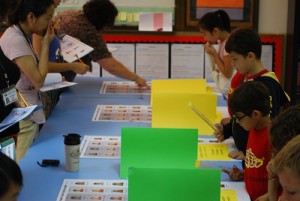By Morgan Elyse Christensen
The girl wants everything in pink and purple. The boy refuses to even look at anything that is. She wants to read books and play with fluffy kittens. He wants to laugh at farts and destroy things in video games. Trying to debunk stereotypes and teach 10-year-olds the importance of gender equity in a 4th grade world where these boy/girl clichés are all that seem to give them a sense of identity – especially with schoolmates – seems to be almost a lost cause. However, after having a reassuring conversation with my boy/girl twins about feminism from their perspectives, I have a feeling that, on a deeper level, I must be doing something right.
We talked about equal pay for women, women’s representation in the arts, and the illusion of male over female competency on the job. I told them that, on average, men make more money than women and that there are less works of art by female artists in most museums all over the world. My son gasped and said, “That’s not fair!” I said, “I know!”

Recently, their school held elections for school council. I asked them if they thought girls and boys were treated equally in the election. “Of course”, I thought to myself, “At this age they’ll surely be about equal.” To my surprise, however, my son replies, “A lot of people don’t vote for the girls because they think they’ll turn the school all girly-girlish like make the school paint the walls pink and put unicorns on them.”

Apparently, last year, there was only one girl on the council as treasurer. Contrariwise, this year the school has elected female members for the roles of president, vice president, and treasurer. Well, aren’t we just a little mirror of our 2013 Congress? On a side note, my daughter had her own thoughts about the voting process outside of the girl vs. boy agenda and, my, does she have a grasp on politics already. In her words: “Running for student council is just a huge popularity contest…I didn’t just vote for who was popular, though.”
So I asked them how they did vote and my son said, “Well, I voted for the girls because they were cut out for the job (I know, right?). They actually do their work in class. The boys who were running this year just goof off in school and on the bus.” My daughter said she voted for the girls as well. I asked her if that was just because they were girls like her, but she “didn’t just choose the girls because they were girls – they were just the people who worked best in class.”

So, despite their arguments over what’s “for girls” or what’s “for boys” and them passing this mentality on to their 5-year-old little brother (which, frankly, makes me cringe every time he says, “I want to play a boy song” because a female artist’s track is on Just Dance 3), I know that the underlying message is getting through. Whether it’s the little things like my youngest son finding a bottle of Hello Kitty bubbles in his stocking or the big moments like having these meaningful conversations, it’s working. I just hope that as they get older, and start to realize the physical differences in gender and their respective peer groups become even more influential, that I can maintain their understanding of equality between boy and girl, man and woman in the areas that truly matter.